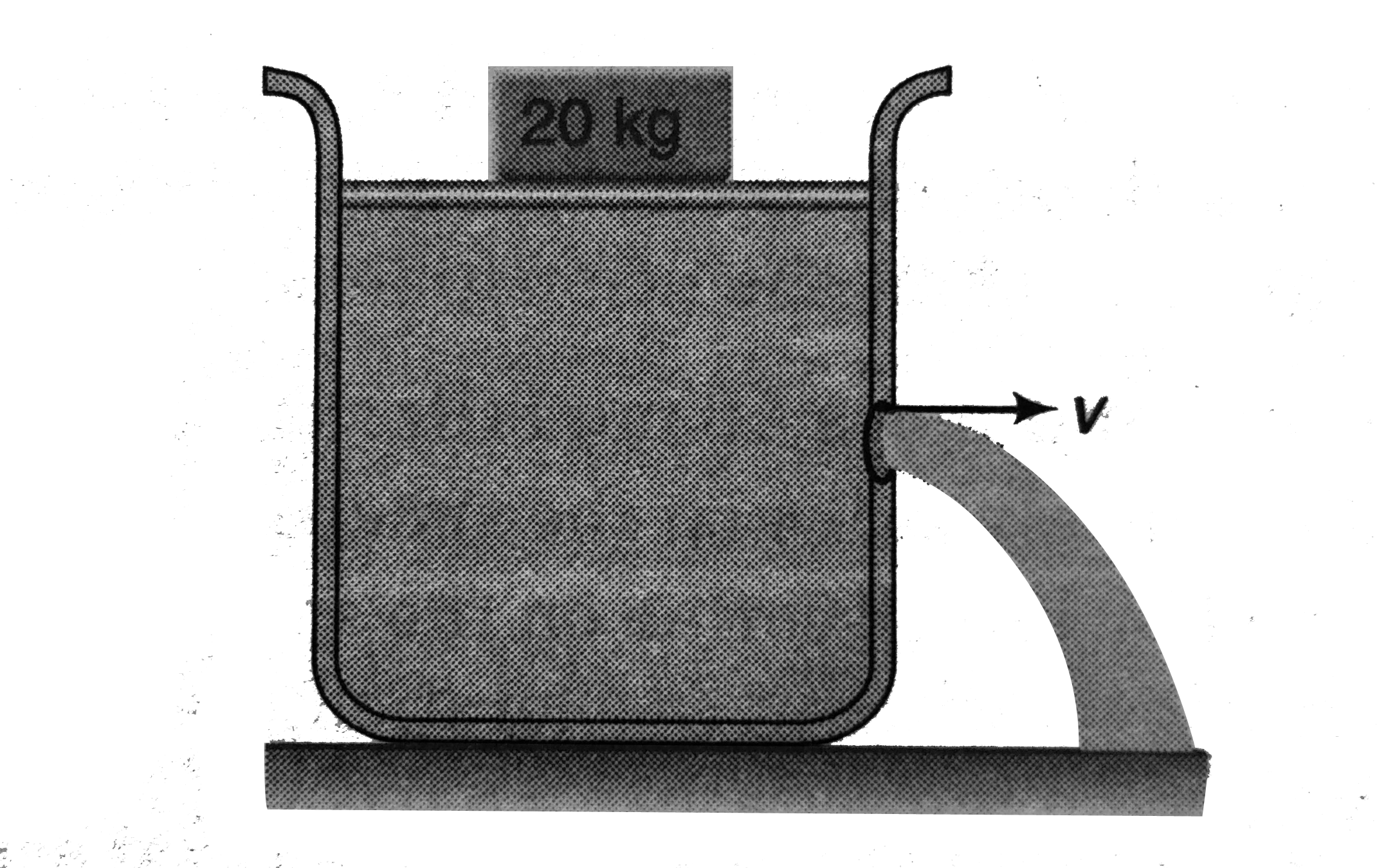A cyclinderical vessel of cross-sectional area 1000cm2, fitted with a frictonless piston of mass 10kg, and filled with water completely. A small hole of cross-sectional area 10mm2 is opened at a point 50cm deep from the lower surface of the piston. The velocity of efflux from the hole will be
10.5m/s
3.4m/s
0.8m/s
0.2m/s
The correct Answer is:B
To find the velocity of efflux from the hole in the cylindrical vessel, we can use Torricelli's theorem, which states that the speed of efflux of a fluid under the force of gravity through an orifice is given by the equation:
v=√2gh
where:
- v is the velocity of efflux,
- g is the acceleration due to gravity (approximately 9.8m/s2),
- h is the height of the fluid column above the hole.
1. Identify the parameters:
- Cross-sectional area of the vessel, A=1000cm2=0.1m2
- Mass of the piston, m=10kg
- Depth of the hole from the lower surface of the piston, d=50cm=0.5m
- Density of water, ρ=1000kg/m3
- Acceleration due to gravity, g=9.8m/s2
2. Calculate the pressure exerted by the piston:
F=mg=10kg×9.8m/s2=98N
The pressure P at the depth of the hole is given by:
P=FA=98N0.1m2=980Pa
3. Calculate the height of the water column above the hole:
The total height of the water column H is the height of the piston plus the height of the water above the hole. The height of the water column above the hole is:
h=H−d
To find H, we can use the relationship between pressure and height:
P=ρgh⟹h=Pρg
Substituting the values:
h=980Pa1000kg/m3×9.8m/s2=0.1m=10cm
Therefore, the height of the water column above the hole is:
H=d+h=0.5m+0.1m=0.6m
4. Calculate the velocity of efflux:
Using Torricelli's theorem:
v=√2gh=√2×9.8m/s2×0.6m=√11.76≈3.43m/s
5. Final result:
The velocity of efflux from the hole is approximately 3.4m/s.
Conclusion:
The velocity of efflux from the hole will be 3.4m/s.
- v is the velocity of efflux,
- g is the acceleration due to gravity (approximately 9.8m/s2),
- h is the height of the fluid column above the hole.
- Cross-sectional area of the vessel, A=1000cm2=0.1m2
- Mass of the piston, m=10kg
- Depth of the hole from the lower surface of the piston, d=50cm=0.5m
- Density of water, ρ=1000kg/m3
- Acceleration due to gravity, g=9.8m/s2
F=mg=10kg×9.8m/s2=98N
The pressure P at the depth of the hole is given by:
P=FA=98N0.1m2=980Pa
The total height of the water column H is the height of the piston plus the height of the water above the hole. The height of the water column above the hole is:
h=H−d
To find H, we can use the relationship between pressure and height:
P=ρgh⟹h=Pρg
Substituting the values:
h=980Pa1000kg/m3×9.8m/s2=0.1m=10cm
Therefore, the height of the water column above the hole is:
H=d+h=0.5m+0.1m=0.6m
Using Torricelli's theorem:
v=√2gh=√2×9.8m/s2×0.6m=√11.76≈3.43m/s
The velocity of efflux from the hole is approximately 3.4m/s.
The velocity of efflux from the hole will be 3.4m/s.
Topper's Solved these Questions
Similar Questions
A long cylindrical tank of cross-sectional area 0.5m2 is filled with water. It has a small hole at a height 50cm from the bottom. A movable piston of cross-sectional area almost equal to 0.5m2 is fitted on the top of the tank such that it can slide in the tank freely. A load of 20kg is applied on the top of the water by piston, as shown in the figure. Calculate the speed of the water jet with which it hits the surface when piston is 1m above the bottom. (Ignore the mass of the piston)
 View Solution
View SolutionA piston of cross-sectional area 100cm2 is used in a hydraulic pressure to exert a force of 107 dyne on the water. The cross-sectional area of the other piston which support a truck of mass 2000 kg is
View Solution
Knowledge Check
- Question 1 - Select One
In a vessel containing water, a hole is made at a depth of 0.10 m from the free surface. What would be the velocity of efflux ?
A14m/sB4m/sC20.8m/sD1.4m/s - Question 2 - Select One
A cylindrical tank having cross-sectional area A is filled with water to a height of 2.0 m. A circular hole of corss-section area is opened at a height of 75 cm from the bottom. If a/A=√0.2, then velocity with which waer emerges from the hole is
(g=9.8ms−2)A4.9ms−1B4.95ms−1C5.0ms−1D5.5ms−1 - Question 3 - Select One
A liquid of density ρ is filled in a vessel up to height H and a hole of cross section area A is made at a depth h below the free surface of liquid. The speed of liquid coming out of the hole is independent of
AhBaCρDg
A tank of height 5 m/s completely filled with water. There is a hole of cross sectional area 1cm2 near its bottom. What is the initial volume of water that will come out of the hole per second. (Use g=10m/s2)
View SolutionA piston of cross-sectional area 100cm2 is used in a hydraulic pressure to exert a force of 107 dyne on the water. The cross-sectional area of the other piston which support a truck of mass 2000 kg is
View SolutionA lawn sprinkler has 20 holes, each of cross-sectional area 2.0x10−2cm2, and is connected to a hose pipe of cross sectional area 2.4cm2. If the speed of water in the hose pipe is 1.5ms−1, the speed of water as it emerges from the holes is
View SolutionThe self inductance of a solenoid that has a cross-sectional area of 1cm2, a length of 10 cm and 1000 turns of wire is
View SolutionA block of mass 500kg is suspended by wire of length 70 cm. The area of cross-section of wire is 10 mm2. When the load is removed, the wire contracts by 0.5cm. The young's modulus of the material of wire will be
View Solution

